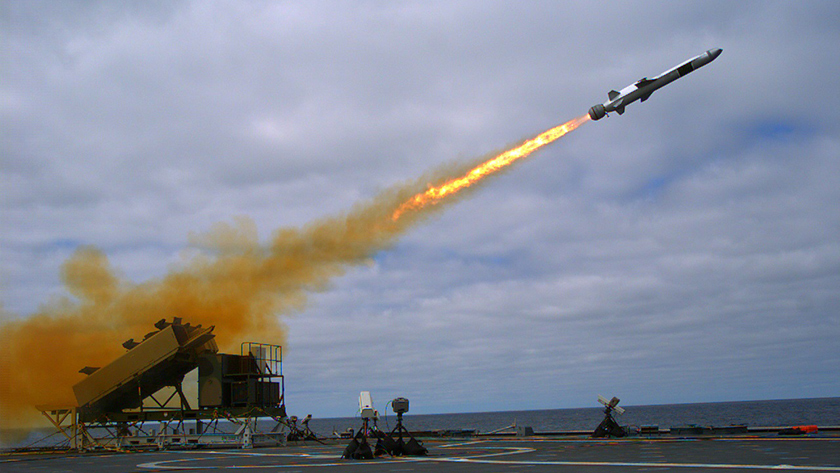
Naval Strike Missile
WASHINGTON: After years of discussion, the Navy and Marine Corps are getting ready to see if they can fit long-range anti-ship missiles aboard amphibious ships, expected to play a bigger role in challenging Chinese claims in the Pacific.
Placing the Naval Strike Missile on these smaller flattops would be in keeping with the push to add more punch to the US fleet, as China and Russia push their own long-range weapons out to sea.
“We have these magnificent 600-foot-long, highly survivable, highly LPD 17s,” Marine Maj. Gen. Tracy King, the Navy’s director of expeditionary warfare, told reporters. “The LPDs need the ability to reach out and defend themselves and sink another ship. It’s not from the aspect of using them as a strike platform; it will drastically increase their survivability if the enemy has to honor that threat.”
The Naval Strike Missile, the result of a Raytheon-Kongsberg partnership, is being installed on Littoral Combat Ships and the Constellation-class guided-missile frigate.
The NSM has already been installed on the USS Gabrielle Giffords, and has been a big part of the Navy and Marine Corps’ plans to give Marines ashore and afloat more punch to protect the fleet.
The Corps has been working for about two years to figure out a way to fire long-range anti-ship missiles from shore-based ground vehicles to add more punch to the Navy’s growing anti-ship capabilities. Last year, Raytheon was awarded $48 million to integrate the NSM into the Marine Corps’ force structure, following a year-long study the Corps conducted, where it also considered Lockheed Martin’s new Long-Range Anti-Ship Missile and Boeing’s Harpoon.
It’s all still a work in progress, however.
“We’re working with Raytheon and other partners to see if they can increase production to get it out there,” King said. “I suspect what you will see in the next year we will probably test-fire a system off of an L-class ship and let the fleet play around with it, build up the doctrine on how we will use it and to confirm or deny whether it is worth the expense, which we think it is. We need the operators to confirm that.”
Getting more firepower on amphibs, slated to be the vanguard for the Navy’s deployment of F-35Bs for years to come as aircraft carriers are being slowly modified to handle F-35Cs, will allow amphibs to push into places like the South China Sea and North Atlantic with better protection.
Adding the missiles might also partially answer another pressing need.
Over the next decade the Navy will retire all its 22 cruisers, losing hundreds of Tomahawk missile tubes as the new class of smaller Constellation-class frigates begins to enter the fleet. Those decomisisonings are part of the 30-year shipbuilding plan unveiled in December, and are taken into account in the long-awaited Future Navy Force Structure plan, also released last month.
Speaking with reporters on Friday, Chief of Naval Operations Adm. Mike Gilday said the plan assumes a 4% annual growth in the Navy’s budget in order to get the fleet up to 355 ships by the 2040s.
That growth is hardly a sure thing when budgets are expected to be flat, or decline in the coming year. “If you want to get growth, I would tell you unless I had that 4% growth I can’t afford a Navy of more than, 305 to 310 ships.”
Chairman of the Joint Chiefs Gen. Mark Milley, in a blunt and often surprising set of remarks last month, said he’s willing to press the other services to give up funding to ensure the Navy gets the money it needs to grow.
“It’s a very, very difficult exercise we’re going to have to go through,” he said. “It’s going to be ruthless. There’s going to be a lot of bloodletting and a lot of stuff left on the floor. We’re gonna have to do that in the coming years — no question about it.”
The Trump administration has tried to put its finger on the scale, drafting and releasing a $759 billion 2022 defense budget in the lame duck session which would eliminate the entire Overseas Contingency Operations account, trim 1,300 soldiers from the Army and massively swell Navy shipbuilding accounts.
Under this unlikely plan, the Navy would get roughly $167 billion for designing and building more than 100 new manned and unmanned ships over the next several years, as well as overhauling nuclear aircraft carriers.
Overall, the cuts would help pay for the 82 ships and 21 unmanned vessels the Navy is currently planning to buy, while also pumping cash into shipyards. The Navy shipbuilding account would swell to $27 billion in 2022, a huge increase from the $19 billion requested in 2021, and a topline of $33 billion by 2026.
The Biden team, clearly, will have its own vision for the defense budget, which it is expected to release in April.






















